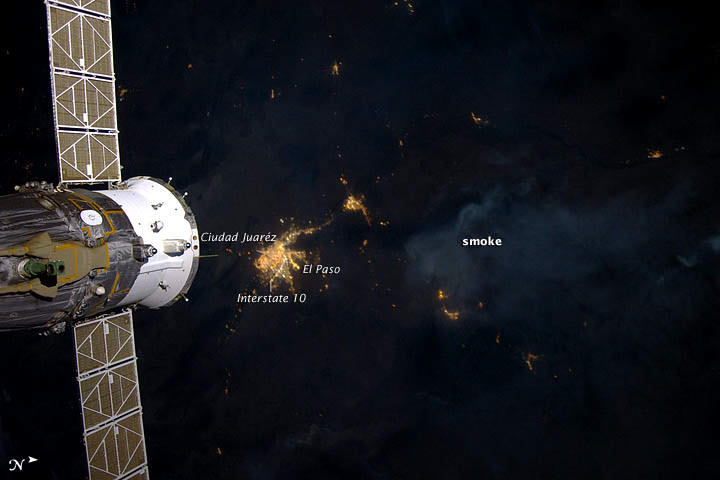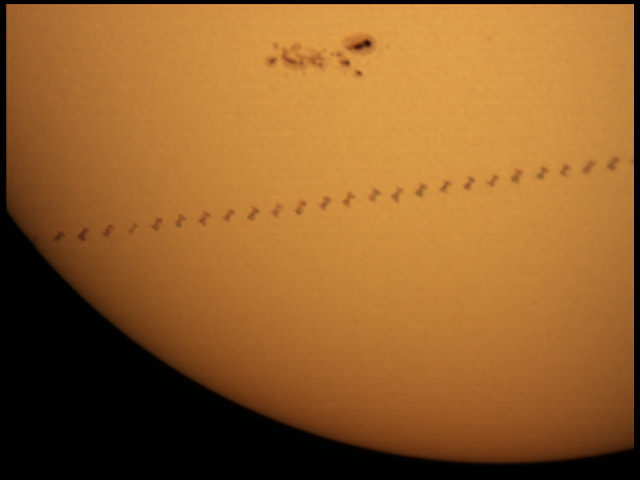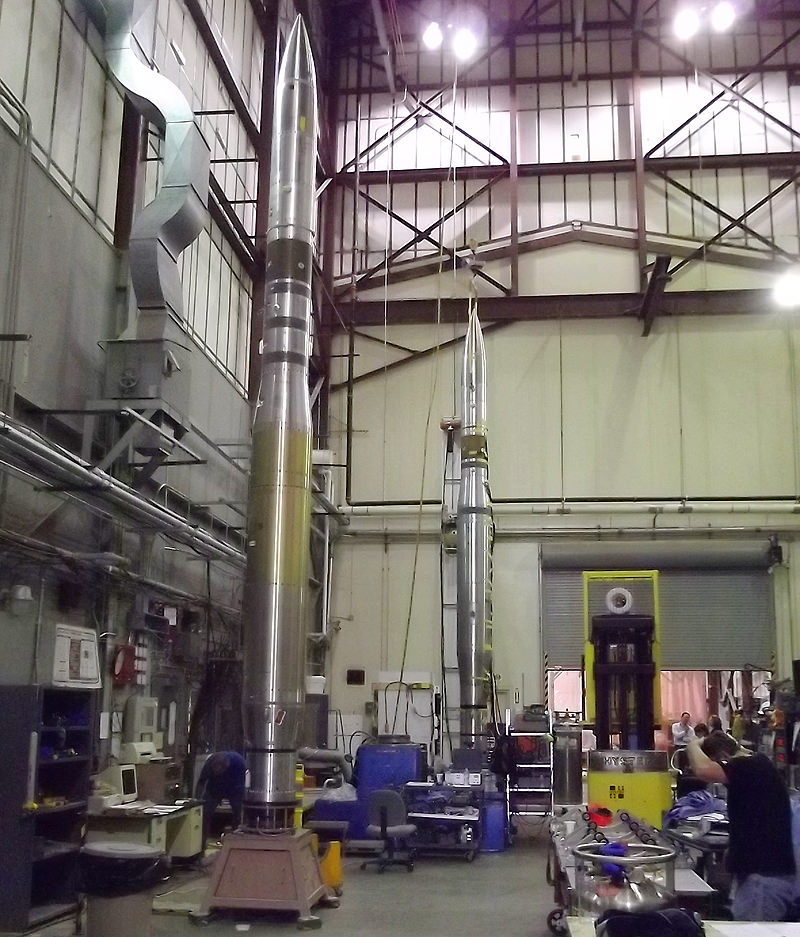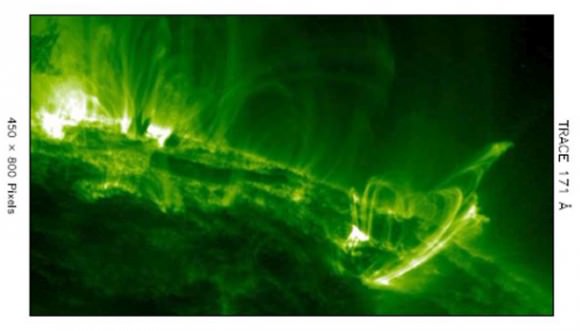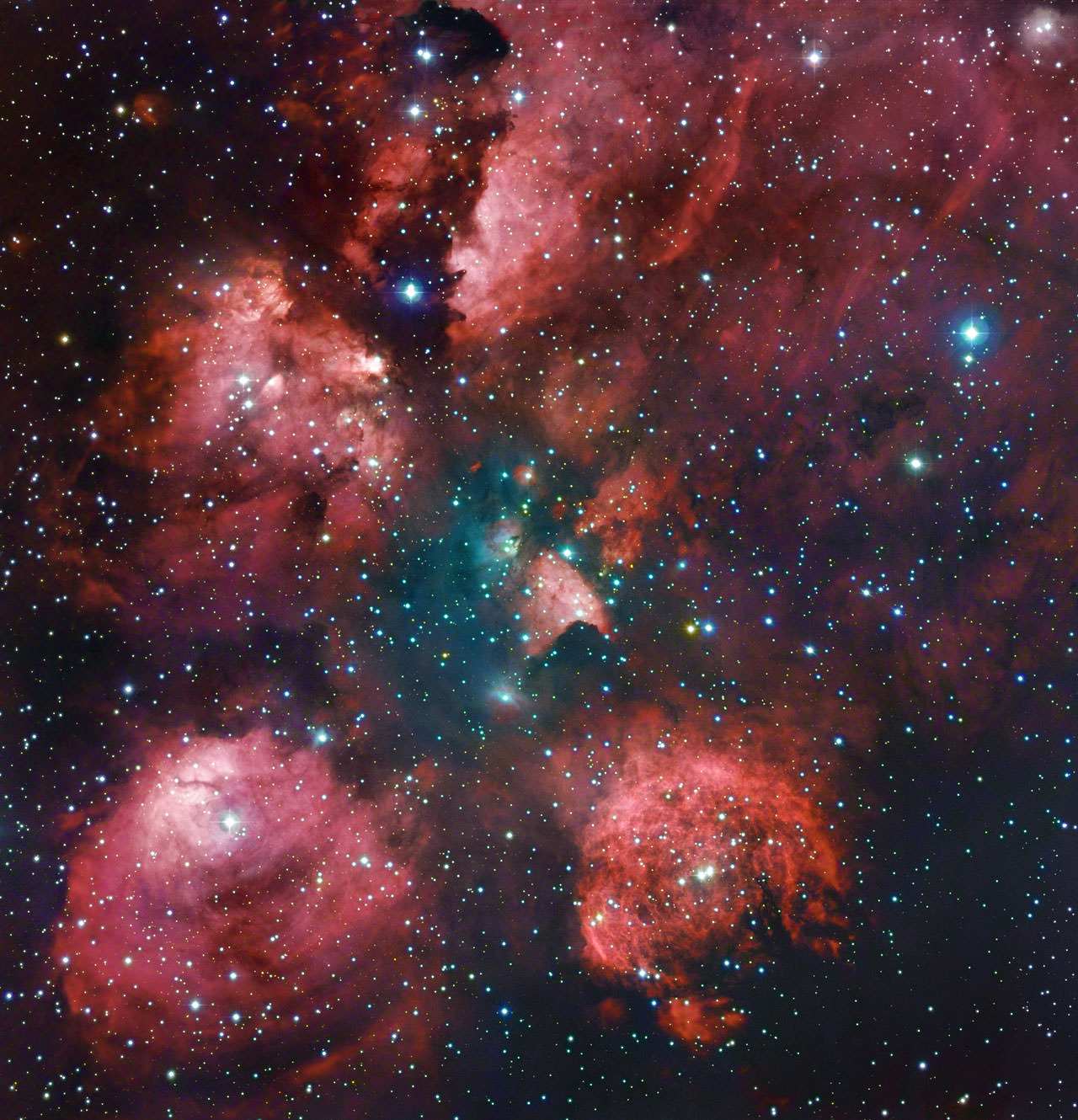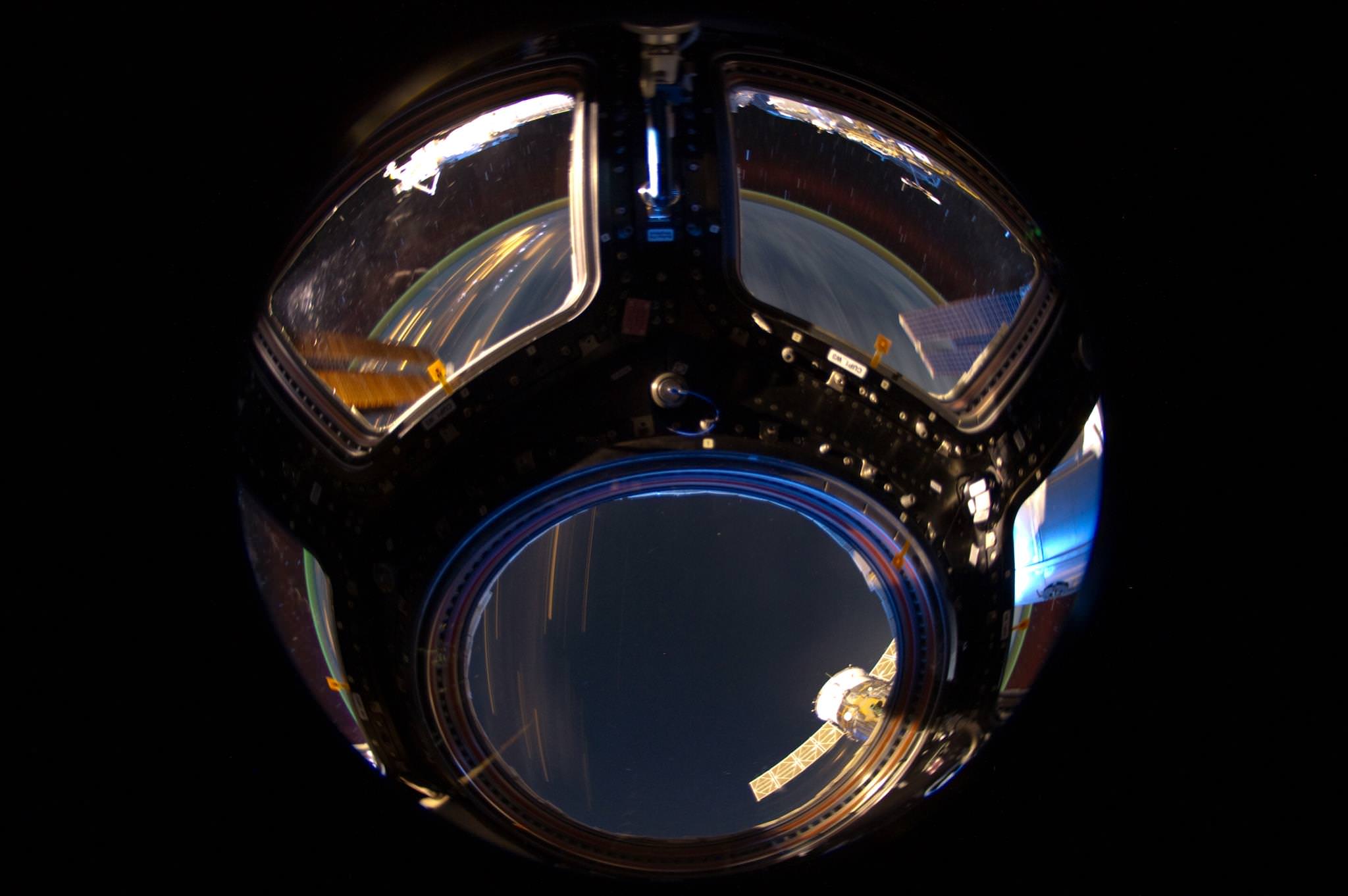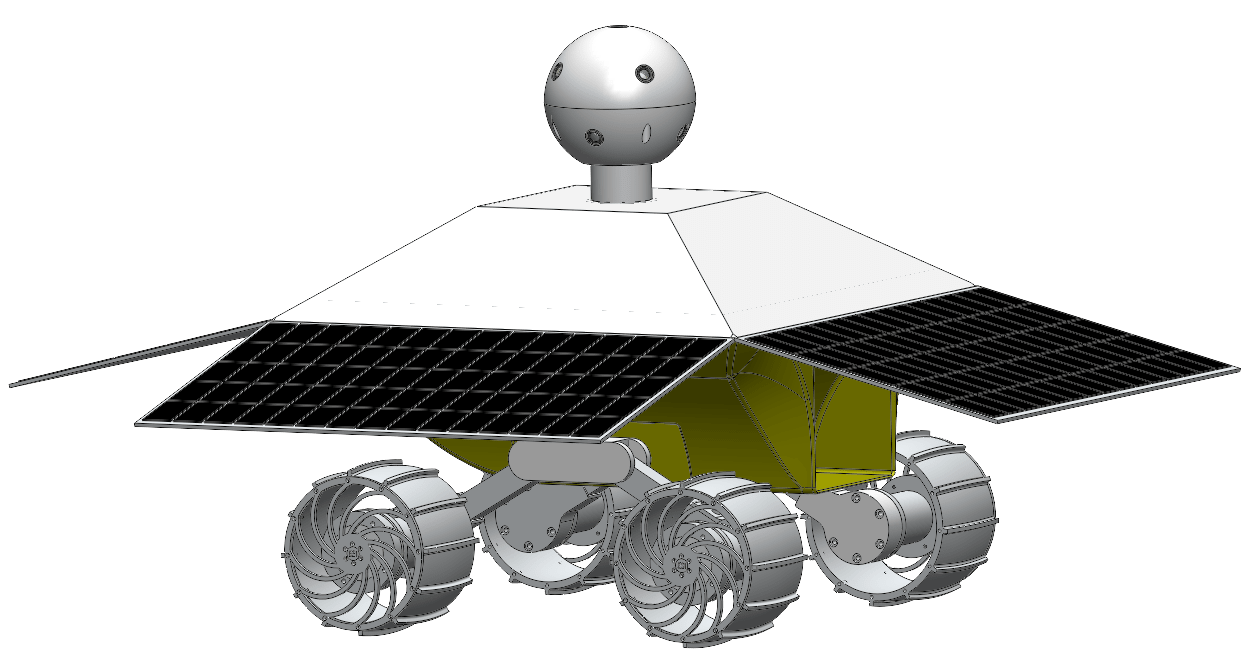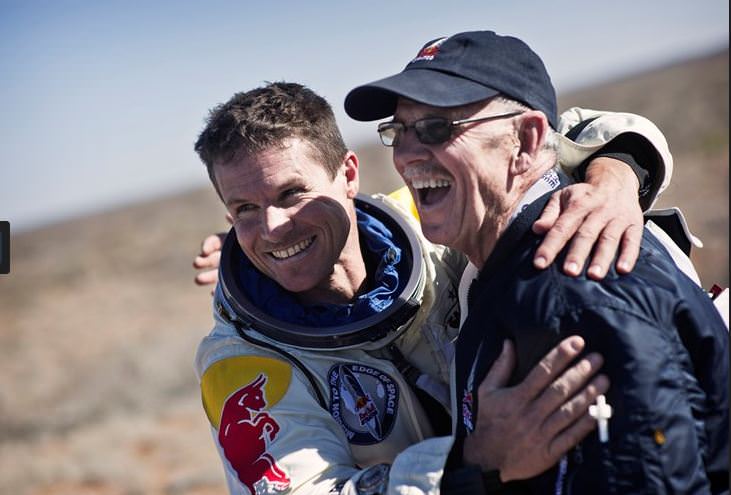The Whitewater-Baldy fire is the largest wildfire in New Mexico’s history and has charred more than 465 square miles of the Gila National Forest since it started back on May 16, 2012 after several lightning strikes in the area. This wildfire produced so much smoke that it was visible even at night to the astronaut photographers on the International Space Station. This image was taken on June 2, 2012 by the crew of Expedition 31 on the ISS, with a Nikon D3S digital camera. A Russian spacecraft docked to the station is visible on the left side of the image.
Credit: NASA Earth Observatory website.
Things on the Sun: Zipper, Airplane and Spots
Caption: ISS Solar Transit. Credit: Fred Locklear.
A couple of awesome pictures of the Sun today from amateur astrophotographers: Above is a composite view of the International Space Station transiting across the Sun, making it look like a zipper on the Sun’s face. This great image is by Fred Locklear (zAambOni on Flickr) using a Celestron C6-N and a SPC900NC webcam. Also visible is the big region of sunspots that spewed out dozens of flares this past week. Fred took this image on July 1, 2012.
What else can we find on the Sun?
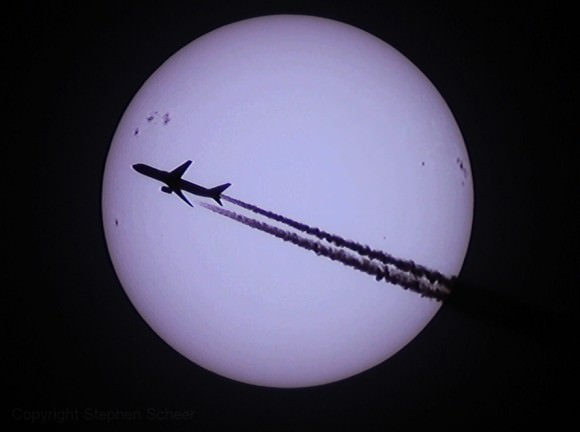
Caption: A plane crossing the Sun. Credit: Steve Scheer.
This incredible shot of an airplane crossing the Sun was taken by Steve Scheer on July 7, 2012.
“Luck was on my side as I happened to go outside and saw a plane about 90 deg away from the Sun,” Scheer wrote UT, “so I quickly setup the scope, pulled the battery off charge, fitted the camera to the scope, pointed to the Sun and crossed the fingers. Luckily the focus was already set from a previous Moon imaging session as I had literally seconds to spare.”
More spots show up on this image including the monster new Active Region AR1520 on the left, which is larger than Jupiter.
Specs:
Telescope- C102-HD refractor
Camera- 500D with t-ring
Solar filter
Want to get your astrophoto featured on Universe Today? Join our Flickr group or send us your images by email (this means you’re giving us permission to post them). Please explain what’s in the picture, when you took it, the equipment you used, etc.
NASA To Launch The Finest Mirrors Ever Made
This Wednesday NASA will launch its High Resolution Coronal Imager (HI-C) mission from White Sands Missile Range in New Mexico, sending a sounding rocket above the atmosphere with some of the best mirrors ever made to capture incredibly-detailed ultraviolet images of our Sun.
HI-C will use a state-of-the-art imaging system to focus on a region near the center of the Sun about 135,000 miles (271,000 km) across. During its brief flight — only ten minutes long — HI-C will return some of the most detailed images of the Sun’s corona ever acquired, with a resolution five times that of previous telescopes… including NASA’s Solar Dynamics Observatory.
While SDO collects images in ten wavelengths, however, HI-C will focus on just one: 193 Angstroms, a wavelength of ultraviolet radiation that best reveals the structures of the Sun’s corona present in temperatures of 1.5 million kelvin. And although HI-C’s mirrors aren’t any larger than SDO’s — about 9.5 inches in diameter — they are “some of the finest ever made.” In addition, an interior “maze” between mirrors effectively increases HI-C’s focal length.
Researchers expect HI-C’s super-smooth mirrors to resolve coronal structures as small as 100 miles (160 km) across (0.1 arcsec/pixel).
“Other instruments in space can’t resolve things that small, but they do suggest – after detailed computer analysis of the amount of light in any given pixel – that structures in the sun’s atmosphere are about 100 miles across,” said Jonathan Cirtain, project scientist for HI-C at NASA’s Marshall Space Flight Center. “And we also have theories about the shapes of structures in the atmosphere, or corona, that expect that size. HI-C will be the first chance we have to see them.”
One of the main goals of HI-C will be to place significant new constraints on theories of coronal heating and structuring, by observing the small-scale processes that exist everywhere in hot magnetized coronal plasma and establishing whether or not there are additional structures below what can currently be seen.
“This instrument could push the limits on theories of coronal heating, answering questions such as why the temperature of the sun’s corona is millions of degrees higher than that of the surface,” said Marshall’s Dr. Jonathan Cirtain, heliophysicist and principle investigator on the mission.
Read more on the NASA news release here.
Top image: A Black Brant sounding rocket containing NASA’s HI-C mission will launch on July 11, 2012 to observe the sun’s corona. (NASA) Bottom image: TRACE image of the Sun at a resolution of 0.5 arcsec/pixel. HI-C will have a resolution 5 times finer.
Remastering a Cosmic Cat Print
Glowing red against a backdrop of stars, amateur astronomers have remastered one of the sky’s most distinctive nebulae, the Cat’s Paw Nebula.
In a stunning combination of data from amateur and professional telescopes, Robert Gendler and Ryan M. Hannahoe mixed their 60 hours of exposures of the nebula on a 0.4-meter telescope with existing images from the 2.2-meter MPG/ESO telescope at the La Silla Observatory in Chile. (See the original image.)
The result is nothing short of beautiful (zoom into all its nebular grandeur at StarryCritters.com). The Cat’s Paw Nebula, also known as NGC 6334, Gum 64 and the Bear Claw Nebula, is found about 5,500 light-years from Earth toward the constellation Scorpius, the Scorpion. The nebula is one of the most active star-forming regions in the Milky Way Galaxy, spanning about 50 light-years, and contains thousands of new stars although most are hidden in the dense clouds of gas and dust. Blistering ultraviolet radiation from these stars excites hydrogen atoms within the star cloud causing it to glow with a characteristic red hue. English astronomer John Herschel first described the nebula in 1837 while observing from the Cape of Good Hope in South Africa.
Anyone using Adobe Photoshop might be familiar with the process used. By combining the luminance, or brightness, of the ESO image with color information from the pair’s long exposures, Gendler and Hannahoe were able to bring out more vibrant color, such as the faint blue nebulosity near the center of the nebula and surrounding some of the brighter stars. The image from the ESO telescope adds finer details.
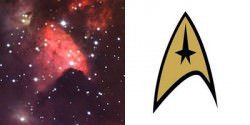 Does anyone else see the similarity between the arched shape in the middle of the nebula with the Federation insignia from the popular television series Star Trek?
Does anyone else see the similarity between the arched shape in the middle of the nebula with the Federation insignia from the popular television series Star Trek?
Image Credit: ESO/R. Gendler & R.M. Hannahoe
A Sci-Fi View from the ISS
What an awesome image of the Cupola on the International Space Station, with a view of Earth whizzing by! But, is the astronaut-photographer on the outside looking in, or on the inside looking out of the Cupola? We know it is taken from the inside, with a view of the Pacific Ocean near Mexico’s Baja Peninsula, but it offers a stunning and futuristic — if not somewhat perplexing — perspective. It was captured at 04:59 GMT June 26, 2012. Credit: NASA
Astronomy Cast Ep. 267: Infinities

Forever is a funny thing. Today we’re going to talk about infinities. That’s right, all the different kinds of possible infinities. How you add them, subtract them, and use them to think about the scale of the Universe.
Click here to download the episode.
Or subscribe to: astronomycast.com/podcast.xml with your podcatching software.
“Infinities” on the Astronomy Cast website.
And the podcast is also available as a video, as Fraser and Pamela now record Astronomy Cast as part of a Google+ Hangout:
Continue reading “Astronomy Cast Ep. 267: Infinities”
Kickstart Your DNA (And a Rover) To The Moon!
Omega Envoy, the non-profit research lab Earthrise Space, Inc.’s team competing for the Google Lunar X PRIZE, has launched a Kickstarter project to help fund a 4-axis CNC milling machine needed to continue development on their proposed lunar rover. CNC machines don’t come cheap, but in typical Kickstarter fashion Earthrise Space is offering incremental rewards to anyone who donates to their project — from mentions on their site to t-shirts, Moon globes and facility tours (and even 5-gallon tubs of duck sauce) and, if you’re lucky enough to have deep pockets and a desire to help a student training ground get their designs off the ground, you can even have your DNA sent to the Moon!
From the Google Lunar X PRIZE article:
For the first time in human history, individuals will have the opportunity to send a sample of their DNA to the lunar surface. For a pledged donation of $10,000 or more, ESI will collect your DNA sample, package it into a storage container mounted on the company’s Lunar Descent Vehicle and fly it to the surface of the moon where it will be preserved for all time.
“We are excited to be exploring new approaches for fundraising and for public engagement, including through the crowdsourcing Kickstarter platform,” said ESI’s Chief Operating Officer (COO) Joseph Palaia. “We are hopeful that this Kickstarter project helps us to make significant progress towards our near-term fundraising goals, while also providing some incredible rewards for our supporters.”
With the Google Lunar X PRIZE, a total of $30 million in prize money is available to the first privately funded team to safely land a robot on the surface of the Moon, have that robot travel 500 meters over the surface, and send HD video, images and data back to Earth.
Of the 26 teams in the competition, ESI is one of only six teams which have been selected for a NASA Innovative Lunar Demonstrations Data contract worth up to $10M. But the contract is awarded incrementally and a multi-axis CNC machine is needed to take their designs to the next level (and meet upcoming contract goals.) Donate to their Kickstarter project here.
At whatever level you contribute, know that you are helping students build real spacecraft, and you’re going to be getting some pretty amazing rewards as well! The students appreciate your support!
— Omega Envoy team, ESI
Find out more about ESI’s project on the Earthrise Space Inc. website, and check out the other Google Lunar X PRIZE competitors here.
Source: Google Lunar X PRIZE blog
Supersonic Freefall: What Felix Baumgartner’s 37-km Jump Will be Like
Sometime this summer, Austrian skydiver Felix Baumgartner will leap from the edge of space, attempting to not only break the sound barrier with his body, but also break the record for the longest freefall. As no one has successfully jumped from this height before, it’s uncertain what the highest supersonic freefall in history will look or feel like. This animated video put out by the Red Bull Stratos team provides a sense of what to expect during the attempt.
“After years of training with my team of dedicated Red Bull Stratos experts, I’ll be going on a journey that no one has ever done,” Baumgartner told Universe Today in 2010 in an email message. “If I succeed, I will be the first person to break the sound barrier, alone. That will be a record for all eternity. As such, a piece of me will become immortal. That excites me.”
42-year-old Baumgartner is hoping to jump from nearly 37 km (23 miles, 120,000 feet) to break the current jump record held by Joe Kittinger a retired Air Force officer, who jumped from 31,500 meters (31.5 km, 19.5 miles, 102,000 ft) in 1960. Now 83, Kittinger is assisting Baumgartner in preparations for the jump.
There have been several attempts to surpass Kittinger’s record, but none have succeeded, and people have given their lives for the quest. Kittinger’s jump contributed valuable data that provided ground work for spacesuit technology and knowledge about human physiology for the US space program.
Image caption: Felix Baumgartner and life support engineer Mike Todd celebrate after landing of the first manned test flight for the Red Bull Stratos in Roswell, New Mexico on March 15, 2012. Credit: Red Bull Stratos.
If Baumgartner is successful, the Red Bull Stratos mission will break four world records: the altitude record for freefall, the distance record for longest freefall, the speed record for fastest freefall by breaking the speed of sound with the human body, and the altitude record for the highest manned balloon flight.
How fast will Baumgarter need to go to beat the speed of sound? Sound travels at different speeds through the atmosphere (as well as through different mediums), depending on atmospheric density and temperature. For example, at sea level, in average conditions of about 15 degrees C (59 degrees F), sound travels at around 1,223 kph (760 mph). But at higher altitudes, where the air is colder, sound travels more slowly.
Researchers with the Red Bull Stratos mission anticipate Baumgartner could break the sound barrier at about 30,480 meters (100,000 feet) above sea level, in temperatures of -23 to -40 C (-10 to -40 F) where sound travels at about 1,110 kph (690 mph) or roughly 304 meters per second (1,000 feet per second).
So, he’ll have to go faster than those speeds – or Mach 1 — to be supersonic.
While there is no literal “barrier,” the transition to supersonic speeds can cause problems for aircraft as transonic air movement creates disruptive shock waves and turbulence. Data obtained from Chuck Yeager’s first supersonic flight in 1947 allowed for changes in design of supersonic aircraft to avoid problems. Still, some aircraft do experience problems at that point, and going supersonic has been attributed to some air disasters.
And the human body isn’t designed for supersonic speeds.
“Our biggest concern is that we don’t know how a human unencumbered by aircraft is going to transition through this,” said the project’s Medical Director Dr. Jonathan Clark, a flight surgeon for six space shuttle missions (and husband of astronaut Laurel Clark who died in the Columbia disaster in 2003), who has researched numerous aerospace disasters. “But it’s also exactly what we’re hoping to learn, for the benefit of future space flights.”
Documents provided by the Red Bull Stratos mission say that the data obtained from the mission will be shared with the scientific community, and Clark noted that he expects long-awaited medical protocols to be established as a result.
A live webcast of the Red Bull Stratos freefall will air on the Red Bull Stratos website.
Why Planets Orbit the Sun
[/caption]
In ancient times, astronomers thought that all celestial objects – the Sun, Moon, planets and stars – orbited around the Earth in a series of crystal spheres. But as modern science developed, astronomers were better able to understand our place in the cosmos. They discovered that all the planets, including the Earth, actually orbit around the Sun.
Not only did scientists discover that the simple fact that the planets orbit the Sun, they uncovered the underlying reasons for why. What chain of events led us to our current Solar System, with planets orbiting the Sun?
Astronomers Used to Think the Earth was the Center of the Solar System
 Because we live on Earth, and we see objects passing across our view of the skies, it’s natural to assume that the Earth is the center of the Universe. In fact, this perspective – known as geocentrism – was the default for all ancient civilizations. The Sun, the Moon, the planets and the stars appeared to move around the Earth each day. And because the Earth itself didn’t seem to be moving, astronomers like Ptolemy assumed that Earth was the center of the Universe. In fact, they went so far as to create very detailed models for predicting the motions of objects with a high degree of accuracy, using this completely inaccurate model of the Solar System. The predictions made by Ptolemy were used to make astrological predictions for more than 1500 years, until a much better model came along.
Because we live on Earth, and we see objects passing across our view of the skies, it’s natural to assume that the Earth is the center of the Universe. In fact, this perspective – known as geocentrism – was the default for all ancient civilizations. The Sun, the Moon, the planets and the stars appeared to move around the Earth each day. And because the Earth itself didn’t seem to be moving, astronomers like Ptolemy assumed that Earth was the center of the Universe. In fact, they went so far as to create very detailed models for predicting the motions of objects with a high degree of accuracy, using this completely inaccurate model of the Solar System. The predictions made by Ptolemy were used to make astrological predictions for more than 1500 years, until a much better model came along.
Actually, the Sun is the Center of the Solar System
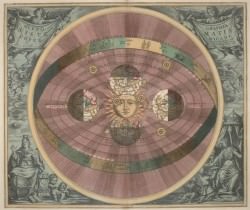 A new, more accurate model of the Solar System didn’t come around until the 16th century, when the Polish astronomer Nicolai Copernicus published his Universe-changing book: On the Revolutions of the Heavenly Bodies. Copernicus accurately reorganized the Solar System, putting the Sun at the center in a heliocentric model. And the Earth took its proper place, as just another planet orbiting the Sun – one of the 6 known to astronomers at the time.
A new, more accurate model of the Solar System didn’t come around until the 16th century, when the Polish astronomer Nicolai Copernicus published his Universe-changing book: On the Revolutions of the Heavenly Bodies. Copernicus accurately reorganized the Solar System, putting the Sun at the center in a heliocentric model. And the Earth took its proper place, as just another planet orbiting the Sun – one of the 6 known to astronomers at the time.
Copernicus’ model helped answer two questions which had troubled astronomers for centuries: why the planets brighten and dim over the course of several months (because they’re getting closer and further away), and why the planets seem to reverse and move in a retrograde direction. Easily explained because of the changing positions of the Earth, planets and the background stars.
But Why Do They Orbit the Sun?
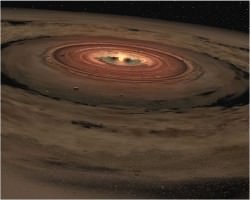 Once they could accurately describe the nature of the planetary motion in the Solar System, they were left with a more fundimental question: Why do the planets orbit the Sun? What sequence of events led to the current motions of the planets around the Sun?
Once they could accurately describe the nature of the planetary motion in the Solar System, they were left with a more fundimental question: Why do the planets orbit the Sun? What sequence of events led to the current motions of the planets around the Sun?
To explain this, we need to look back 4.6 billion years ago, before there was even a Solar System. In our place instead, there was a massive cloud of hydrogen gas left over from the Big Bang. Some event, like a nearby supernova explosion triggered a gravitational collapse of the cloud, causing the hydrogen atoms to attach to one another through mutual gravity.
Each individual hydrogen atom had its own momentum, and so when the atoms collected together into larger and larger clumps of gas, the conservation of momentum across all the particles set these clumps of gas spinning. Imagine two spinning skydivers colliding with one another in mid-air; after their collision, they’ll have a new rotation speed and direction based on the addition of their original directions.
Eventually all of this hydrogen gas was collected together into a massive spinning ball of gas that continued to collapse under its own gravity. As it collapsed, it began to spin faster and faster, just like a figure skater pulling in her arms increases her rotation speed.
The spinning cloud of gas and dust flattened out because of the rotational force, with the Sun at the center, and then a pancake-shaped disc of material surrounding it. The planets formed out of this disk of material, collecting together particles of dust into larger and larger rocks until planet-sized objects had accumulated together.
The Planets are in Perfect Balance
The planets orbit the Sun because they’re left over from the formation of the Solar System. Their current motion depends on the gravitational attraction of the Sun at the center of the Solar System. In fact, they’re in perfect balance.
There are two opposing forces acting on the planets: gravity pulling them inward, and the inertia of their orbit driving them outwards. If gravity was dominant, the planets would spiral inward. If their inertia was dominant, the planets would spiral outward into deep space.
The planets are trying to fly out into deep space, but the gravity of the Sun is pulling them into a curved orbit.
Research further:
Cornell Astronomy
The Universe of Aristotle and Ptolemy
Copernical Model: A Sun-Centered Solar System
The Solar Nebula
On the Revolution of the Heavenly Bodies
The Copernican Revolution

